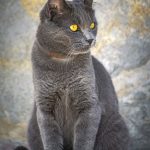Introduction:
Highlander cats, known for their striking resemblance to wild big cats, are a captivating addition to the feline world. With their distinctive appearance, high energy levels, and affectionate personalities, these cats are gaining popularity despite not yet being fully recognized by major cat registries. In this article, we delve into the world of Highlander cats, exploring their characteristics, history, care requirements, and more.
Characteristics of Highlander Cats:
Highlander cats are known for their remarkable features:
- Appearance: Medium to large in size, muscular, and athletic, they have a rectangular body shape with a straight back. Their defining characteristics include a wide nose bridge, blunt profile, and wide-based ears that are loosely curled at the top. Highlanders come in both shorthaired and longhaired varieties, with a range of colors and patterns.
- Temperament: Highlander cats are playful, outgoing, and brimming with energy. They are known for their people-oriented nature and are friendly with almost everyone, including strangers. They form strong bonds with their human families and get along well with other cats and cat-friendly dogs.
- Activity Level: These cats have high energy levels and enjoy playtime, particularly games of chase. Interestingly, they often wag their short tails when happy and playing, a behavior reminiscent of dogs.
History of the Highlander Cat:
The Highlander breed traces its roots to the 1990s when a U.S. cat breeder aimed to create a new breed resembling wild cats. The initial crosses involved the desert lynx and jungle curl cat breeds, leading to the Highlander lynx. Although not recognized by major cat registries, further breeding efforts with domestic cats resulted in today’s Highlander. It now falls under TICA’s Advanced New Breeds Class, making them eligible for TICA-sanctioned cat shows.
Highlander Cat Care:
Highlander cats come in both short and longhaired versions, necessitating different grooming routines. Here are some care tips:
- Grooming: Brush both coat types several times a week with a soft slicker brush to manage shedding. Pay special attention to the longhaired Highlander’s shaggy belly fur to prevent matting. Occasional baths with moisturizing shampoo are recommended for cleanliness and coat health.
- Nail Care: Trim your cat’s nails every other week to keep them at an appropriate length.
- Ear Cleaning: Check your cat’s ears weekly, and if necessary, clean them using a cotton ball or gauze square with a pet ear cleaner.
- Exercise and Play: Highlanders are naturally active, so provide them with opportunities for exploration, climbing, and play. Cat trees, kitty condos, and interactive toys are excellent options.
Common Health Considerations:
Highlander cats do not have known breed-specific health issues. However, like all cats, they can develop various health problems over time. Regular annual check-ups with your veterinarian are essential for maintaining their well-being and detecting any health concerns early.
Conclusion:
Highlander cats are a captivating and unique breed known for their resemblance to wild cats and playful personalities. While they are not fully recognized by major cat registries, their growing popularity attests to their charm. To ensure their happiness and well-being, provide Highlander cats with ample attention, exercise, and grooming care. Whether you’re considering bringing one into your home or simply fascinated by their distinctive traits, Highlander cats are a breed worth exploring.
References:
- The International Cat Association (TICA)
- The American Association of Professional Cat Trainers (AAPCT)



